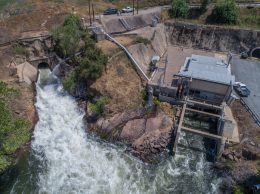Santa Maria Energy’s bid to become a publicly traded company hit a roadblock on April 21 when shareholders in Hyde Park Acquisition Corp. II balked at approving a share swap. Now an April 30 deadline looms with a $120.7 million investment in North Santa Barbara County hanging in the balance.
Santa Maria Energy won approval last year to drill 136 new oil wells in one of the region’s most promising formations. Shortly afterward, it announced a merger with Hyde Park, a so-called blank check firm whose function is to place its investors’ cash into an operating company.
The deal would put Santa Maria Energy on the Nasdaq and pump up to $79 million in fresh capital into the oil firm, which has already secured $50 million in private equity funds from energy-focused Kayne Anderson Capital Advisors.
The merger is a critical piece of Santa Maria Energy’s projected capital budget of $120.7 million. In securities filings, the oil firm says it plans to tap both the merger funds and more private equity for its cash needs. Santa Maria Energy’s investors have already approved the Hyde Park merger.
But at the April 21 shareholder meeting, Hyde Park’s investors spurned the Santa Maria Energy deal, at least for now. Sixty-seven percent voted to push the final vote on the merger back to April 30, signaling there were not enough votes to approve the deal outright.
If Hyde Park’s shareholders don’t approve the deal by May 1, the fund will liquidate and return the $79 million in cash that it holds to its investors.
Santa Maria Energy officials said they could not comment until after the final merger vote.
But it appears that recent disclosures by Hyde Park caused its investors to take a second look. On April 1, Hyde Park said that it had told investors at its initial public offering in 2011 that it would only invest in a target business if the deal gave Hyde Park a controlling stake.
But that won’t be the case with the Santa Maria Energy merger. Even if Hyde Park transfers its full $79 million to Santa Maria Energy, it will own only 38.8 percent of the resulting company, with Santa Maria Energy’s current stockholders owning 61.2 percent.
Hyde Park’s investors also have the option of taking their money back, and if only $40 million is invested into Santa Maria Energy — the minimum threshold required by the deal — then Hyde Park investors will own only 19.5 percent.
In its regulatory filing, Hyde Park explained that it went ahead with the deal because it “does not believe the disclosure contained in its IPO prospectus precluded Hyde Park from pursuing a non-control transaction.”
Hyde Park said it decided to pursue the merger with Santa Maria Energy “based on the substantive benefits of the transaction perceived by Hyde Park’s board of directors, including the potential for value creation for Hyde Park’s stockholders provided by the transaction.”
If the deal doesn’t go through, the $79 million in Hyde Park’s accounts goes back to common stockholders. But the company’s founders — including financier Laurence Levy, who orchestrated the deal — won’t be eligible to receive any cash. Their shares, valued at $26.9 million at the end of March, will become worthless. “Hyde Park stockholders should take this conflict of interest into account,” the company told shareholders.
Kayne Anderson influence
Looming over the deal is Kayne Anderson, a well-known energy private equity firm. It’s Kayne Anderson’s backing that enabled Santa Maria Energy to open large credit lines, including a $50 million senior facility with Mutual of Omaha.
But it is also Kayne Anderson’s prime position in the Santa Maria Energy’s capital structure that makes the deal potentially unappealing to Hyde Park’s investors.
According to Santa Maria Energy’s disclosures, the first $19.4 million raised from Hyde Park would go toward retiring outstanding debt. After that, Hyde Park’s investors would be sitting behind $50 million in preferred shares that would be held by Kayne Anderson.
That $50 million is due with 8 percent interest in either four years or a change in control, whichever comes first. Preferred shares are paid out ahead of common stock when assets are liquidated. That means that Hyde Park’s shareholders are receiving a relatively weak call on Santa Maria Energy’s considerable assets — which include 15.6 million barrels of proved reserves — in return for their cash.
SME’S future unclear
If Hyde Park’s investors scuttle the deal, the fate of Santa Maria Energy is not clear. The company has said it expects to fund its capital expenditure program through a mix of the Hyde Park funds, private equity and borrowings under its credit line.
If Santa Maria Energy raises only the minimum $40 million from Hyde Park and can’t raise private equity, it will have to “significantly modify its capital expenditure program,” according to its filings.
But Santa Maria Energy has pledged virtually all of its property as collateral on its credit facility, leaving equity financing as its only viable path to developing the wells it fought for the permits to drill.
“[T]he failure to obtain additional financing could result in a curtailment of [Santa Maria Energy’s] development and exploration activities, which in turn could lead to a possible loss of properties and a decline in its oil and natural gas reserves as well as [a]materially adversely affect its financial condition,” the company said in its securities filings.






 Print
Print Email
Email

















